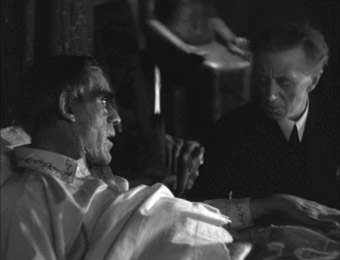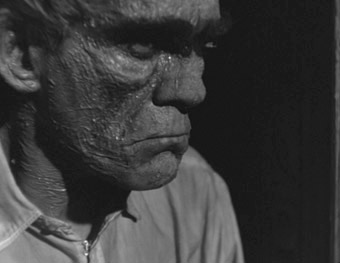|
Perhaps because he first found fame and subsequently made his career in Hollywood, it's sometimes easy to forget that Boris Karloff, aka William Henry Pratt, was an English actor. In spite of that soft, cultured voice that betrays not a trace of American twang, he's rarely associated with the movie industry of his homeland, and yet four major horror movies into his career, Karloff returned to the UK to star – well, more co-star actually – in this rare example of a 1930s British horror piece made in the Hollywood style. For years believed to be a lost film, it was first rediscovered as a poor quality print with Czech subtitles, then more recently a far better copy was found languishing in the BFI vaults, from which the present restoration was made.
Karloff plays Professor Morlant, a dedicated Egyptologist who's teetering on the brink of death. But he has has a plan to survive it, and makes very specific requests to his trusted manservant Laing for a funeral that involves a ritual designed to invoke the power of ancient Egyptian gods, one that will open a gateway to immortality. To secure his passage he has Laing bandage a priceless jewel known as The Eternal Light to his hand, a gem that cost him most of his accrued fortune. Laing is not convinced but participates anyway. "You're afraid of me?" Morlant asks him. "I'm afraid for you," Laing replies. "If this should leave me," Morlant warns him, "then you'll have reason to fear, for when the full moon strikes the door of my tomb, I will come back." And when Boris Karloff promises to return from the dead this early in the film, you can be pretty damned sure that he will keep his word.

Morlant dies and his coffin is placed in his hieroglyph-covered tomb, which is then sealed and the key to the entrance left inside. "Another of his queer fancies," Laing tells surly family lawyer Broughton, who plans to sneakily nab the Eternal Light for himself. But on checking Morlant's body, he finds that it's already gone. Chief suspect is Laing, who has been by his master's side since his death. "You will be putting yourself perilously near dishonesty," Broughton advises the servant. "I've seen men nearer," Laing replies with an accusatory glare. Broughton's not about to give up, and leaves his burly chauffeur Davis to secretly watch the servant. Observing the whole affair from the bushes is Egyptian Aga Ben Dragore, who's looking to retrieve the jewel and return it to his homeland. Realising he's being watched and fearing for his safety, the guilty-as-charged Laing hides the jewel in a coffee pot and flees to London.
It's a brisk twenty minutes of set-up that requests the viewer's full attention but is peppered with rewards along the way, in Morlant's atmospherically shot death bed scene, in the dark wit of the expositional dialogue ("I suppose a great Egyptologist can't be expected to be like other people," remarks the doctor attending Morlant's final moments, to which Broughton gruffly replies "Well he'll be like a great many other people soon") and especially in the casting. Karloff my be the headliner, but as he drops out of the story less than fifteen minutes in and isn't due to reappear until later, the film is handed over to a fine supporting cast that includes Cedric Hardwicke as Broughton, Ernest Thesiger as Laing, and none other than Ralph Richardson – in his first film role – as Nigel Hartley, the region's new vicar. Thesiger in particular is a constant joy, his Scottish accent and fey cynicism lending otherwise sinister proceedings an amusing edge, lighting up the gloom in a manner akin to his work for James Whale in The Old Dark House and Bride of Frankenstein.
Considerably less likeable from the moment he opens his mouth is Morlant's appalling oik of a nephew Ralph, whom we first meet in Broughton's office complaining that he wasn't even told of his uncle's death, and that the £4000 he's been getting a year to sit on his useless arse will now dry up. As played by Anthony Bushell, Ralph really is a toad, angrily barking his dialogue as if he expects the world to jump at his every word. This would probably not be an issue if the awful bugger wasn't being cast as the film's romantic lead, with the girlie half of the union soon introduced as Betty Harlon (played by Dorothy Hyson), Ralph's cousin (hello?) and fellow heir to Morlant's estate, and someone not previously on speaking terms with the oik. That, at least, needs no explanation.
A series of incidents, meetings and intrigues that would take a busy paragraph to clarify bring Ralph, Betty, Betty's friend Kaney (Kathleen Harrison, along to protect Betty from the oik), Pastor Hartley and Broughton together at the Morlant family house. They are soon joined by Aga Ben Dragore, whom Kaney is immediately entranced by, which leads to a scene that directly references Rudolph Valentino's 1921 The Sheik in a manner that will be completely lost on a modern audience. From here, the film takes on the feel of a theatrical murder mystery, but a lively and niftily filmed one that develops an effective Old Dark House vibe once Karloff is revived and on the prowl for the missing jewel.

Although the first real attempt by a British studio to cash in on the runaway success of the American 30s horror cycle, The Ghoul was also, thanks to an increasingly censorious attitude to horror in the UK, one of the few home-grown works of its type, at least of this period. Its fame could thus easily rest with its relative uniqueness at a time of American studio domination of the genre, but The Ghoul surprises and impresses on a number of counts. It's consistently well directed by American import T. Hayes Hunter, atmospherically shot by Austrian cinematographer Günther Krampf – who also worked on Murnau's Nosferatu (1922) and G.W. Pabst's Pandora's Box (1929) – and given that its star is absent from the film's midsection, the story and characters charged with carrying the resulting weight are consistently worthy of interest. Just about everyone present seems to have their eye on the jewel for an intriguing variety of reasons (Morlant for eternal life, Laing because he believes that's all nonsense and the professor's legacy belongs with his family, Aga Ben Dragore because the stone was stolen from his homeland, and Broughton because he's a greedy legal scumbag), while the traditional stalking monster scenes are given a twist by attacks that for the most part result in the victim being let free. And if Kathleen Harrison's comedy relief soon wears thin, then it does at least offer the filmmakers a chance to send up movie-fed western conceptions of Egyptian men.
If you can make allowances for Anthony Bushell's relentless barking of lines, the performances are fine, with Richardson showing a touch of class in his first film role and Karloff once again demonstrating his mastery of physical and facial expression – just watch the close-up when he realises who has taken the stone and settles on his grim course of action.
That The Ghoul has been rescued from obscurity is, for horror fans at least, worth celebrating. It's well made, nicely cast, and intermittently pokes its tongue into its cheek. It's a slice of old school Karloff that may have been made with an eye on the box-office, but one in which – somewhat typically of its celebrated producer Michael Balcon – quality was still the order of the day.
Like Network's simultaneous UK release of Carnival of Souls, The Ghoul has undergone an NTSC to PAL conversion, very likely from MGM's 2003 US release, though fortunately has not suffered the same print and conversion fate, with little in the way of motion problems and only the slightest softening of image sharpness. The contrast range is narrower than top-flight monochrome transfers, with black levels sometimes weakened to provide a degree of shadow detail that would otherwise be lost, but given that this was once a lost film, the print here is in remarkably good shape and there's hardly a dust spot to been seen.

The sound is similarly pleasing – given the film's age, the clarity of the dialogue and lack of distortion is impressive, and there's only a faint background hiss to content with.
Once again Network have provided a Commentary Track by genre writers Kim Newman and Stephen Jones, who are clearly good friends and previously collaborated on the two Horror: 100 Best Books reference works. Both really know their genre movies and appear to have independently researched the film they are commenting on and then met up for the recording itself, which results in a lively debate as they compare opinions and notes for the first time. As with Carnival of Souls, this is a hugely enjoyable and informative track, loaded with learned opinion and interesting facts about the film and those involved in its production, with Newman providing detail on the relationship between the movie and the novel on which it was based and both men chipping in with comparisons to the 1961 comedy remake What a Carve-Up!. It's also Newman who provides the news that Ralph Richardson, when asked about his career on Desert island Discs, named The Ghoul as his favourite film acting job. Occasionally, as on the Carnival of Souls track, they appear a little bemused by detail that made perfect sense to me (I assumed the explosives were being planted to break into the tomb and that Morlant's change of mind about attacking Kaney was because, having been told by Laing only that "the girl" has the jewel, when she raised her hands to wave through the window he could see she was not holding it), but on the basis of this and the Carnival of Souls track, the pair have the potential to become the Bey Logan of horror commentaries. If Network plan to release further horror favourites in the future, I do hope they again engage the services of this pair.
The wrongs done to Carnival of Souls are largely righted here. Good movie, decent presentation and another excellent commentary. More please. Recommended, at least for the horror faithful.
|